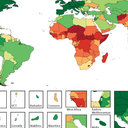Sex differences in diquat-induced hepatic necrosis and DNA fragmentation in Fischer 344 rats.
Mots clés
Abstrait
Redox cycling metabolism of diquat catalyzes generation of reactive oxygen species, and diquat-induced acute hepatic necrosis in male Fischer 344 (F344) rats has been studied as a model of oxidant mechanisms of cell killing in vivo. At equal doses of diquat, female F344 rats sustained less hepatic damage than did male rats, as estimated by plasma alanine aminotransferase (ALT) activities after 6 h. Biliary efflux of glutathione disulfide (GSSG) was greater in male than in female rats at each dose of diquat, but even comparable rates of GSSG excretion were associated with less hepatic injury in female rats. Hepatic activities of superoxide dismutase (SOD) and glutathione peroxidase (GPX) were similar in the two genders, and activities of glutathione reductase (GR) and glutathione S-transferase-alpha (GST-alpha) activities were higher in the male rats. Previous studies in male rats have implicated formation of 2,4-dinitrophenylhydrazine (DNPH)-reactive "protein carbonyls" and related iron chelate-catalyzed redox reactions as mechanisms critical to diquat-induced acute cell death in vivo. However, diquat-treated female rats showed higher levels of DNPH-reactive proteins in livers and in bile than did males, both at identical doses of diquat and at doses that produced similar elevations in plasma ALT activities. In female rats, fragmentation of hepatic deoxyribonucleic acids (DNA) was increased by doses of diquat that did not increase plasma ALT activities, and increased fragmentation was observed prior to elevation of plasma ALT activities. In the present studies, hepatic necrosis was most closely associated with DNA fragmentation, although additional studies are needed to determine the mechanisms responsible for and the pathophysiological consequences of the fragmentation.


